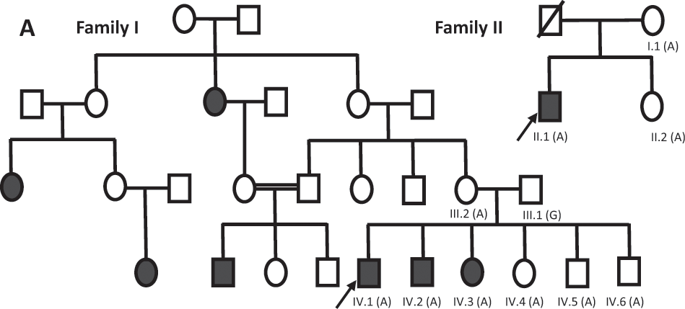Our official English website, www.x-mol.net, welcomes your
feedback! (Note: you will need to create a separate account there.)
First characterization of LHON pedigrees in North Africa
Eye ( IF 2.8 ) Pub Date : 2020-01-02 , DOI: 10.1038/s41433-019-0755-x Aymane Bouzidi 1, 2, 3 , Nisrine Aboussair 4, 5 , Majida Charif 1, 6 , Ghita Amalou 1, 2, 3 , David Goudenège 1, 7 , Valérie Desquiret-Dumas 1, 7 , Céline Bris 1, 7 , Najat Sifeddine 2 , Halima Nahili 2 , Meriem Elqabli 4 , Kenza Dafir 4, 5 , Mostafa Kandil 3 , Patrizia Amati-Bonneau 1, 7 , Vincent Procaccio 1, 7 , Abdelhamid Barakat 2 , Guy Lenaers 1
Eye ( IF 2.8 ) Pub Date : 2020-01-02 , DOI: 10.1038/s41433-019-0755-x Aymane Bouzidi 1, 2, 3 , Nisrine Aboussair 4, 5 , Majida Charif 1, 6 , Ghita Amalou 1, 2, 3 , David Goudenège 1, 7 , Valérie Desquiret-Dumas 1, 7 , Céline Bris 1, 7 , Najat Sifeddine 2 , Halima Nahili 2 , Meriem Elqabli 4 , Kenza Dafir 4, 5 , Mostafa Kandil 3 , Patrizia Amati-Bonneau 1, 7 , Vincent Procaccio 1, 7 , Abdelhamid Barakat 2 , Guy Lenaers 1
Affiliation

|
Leber Hereditary Optic Neuropathy (LHON, MIM #535000) is a rare blinding disease related to the optic nerve degeneration [1]. In most cases reported in the world, the disease is caused by one of the three primary mutations in the mitochondrial genome: m.3460G>A, m.11778G>A, and m.14484T>C in the ND1, ND4, and ND6 genes, respectively [2]. So far, a large number of LHON pedigrees have been described in Europe, Asia, North, and South America. Meanwhile, just one LHON individual originating from Tunisia and living in Italy has been reported with the m.14484T>C mutation [3]. Here we report two Moroccan LHON pedigrees with multiple affected individuals (Fig. 1). Ophthalmological examination of the proband from the first family (IV.1), aged 17 years at first examination, disclosed an asymmetric alteration of the visual fields, the right eye being more severely affected than the left eye, the latter showing a clear centrocecal scotoma (Fig. 2a). Fundus and retinal autofluorescence examinations disclosed a pallor of the optic nerve head (Fig. 2b) and angiographic picture of the left eye revealed some faint telangectasias located close to the optic nerve rim (Fig. 2c); these features fitting with the consensual LHON clinical description [4]. Ophthalmological examination of the other members of the family I were not performed, nor for the members of the family II, although the bilateral acute loss of vision reported for the second family was suggestive of LHON. Together these clinical data prompted the molecular screening of the mitochondrial genome of the proband from both families. Whole mitochondrial genome sequencing on blood DNA evidenced the m.11778G>A mutation in both individuals, which was present at an almost homoplasmic status (99.2% and 99.1% of mutated copies, respectively). Segregation study by Sanger sequencing disclosed that affected members from Family I had the causative mutation, and that its transmission was compatible with maternal lineage, although some carriers were unaffected, as commonly described for women carrying a LHON mutation. Analysis of the full mtDNA sequence revealed that the first family belongs to the J2b1a1 haplogroup, whereas the second one belongs to the T2a1a haplogroup. Search for the presence of mtDNA deletions using the eKLIPSe software [5] did not evidence genome alteration.
中文翻译:

北非 LHON 谱系的首次表征
Leber 遗传性视神经病变 (LHON, MIM #535000) 是一种与视神经变性相关的罕见致盲疾病 [1]。在世界上报道的大多数病例中,该疾病是由线粒体基因组中的三个主要突变之一引起的:ND1、ND4 和 ND6 中的 m.3460G>A、m.11778G>A 和 m.14484T>C基因[2]。迄今为止,已经在欧洲、亚洲、北美洲和南美洲描述了大量的 LHON 谱系。同时,据报道只有一名来自突尼斯并居住在意大利的 LHON 个体具有 m.14484T>C 突变 [3]。在这里,我们报告了两个具有多个受影响个体的摩洛哥 LHON 谱系(图 1)。第一次检查时 17 岁的第一家庭先证者 (IV.1) 的眼科检查显示视野不对称改变,右眼比左眼受到的影响更严重,后者显示出清晰的中心盲点(图 2a)。眼底和视网膜自发荧光检查显示视神经乳头苍白(图 2b),左眼血管造影显示一些位于视神经边缘附近的微弱毛细血管扩张(图 2c);这些特征符合双方同意的 LHON 临床描述 [4]。没有对家族 I 的其他成员进行眼科检查,也没有对家族 II 的成员进行眼科检查,尽管报告的第二个家族的双侧急性视力丧失提示 LHON。这些临床数据共同推动了对两个家族先证者线粒体基因组的分子筛选。血液DNA全线粒体基因组测序证实了m.11778G> 两个个体中的突变,几乎以同质状态存在(分别为 99.2% 和 99.1% 的突变拷贝)。通过 Sanger 测序进行的分离研究表明,来自家族 I 的受影响成员具有致病突变,并且其传播与母系谱系一致,尽管一些携带者不受影响,如携带 LHON 突变的女性的常见描述。对完整 mtDNA 序列的分析表明,第一个家族属于 J2b1a1 单倍群,而第二个属于 T2a1a 单倍群。使用 eKLIPSe 软件 [5] 搜索 mtDNA 缺失的存在并没有证明基因组改变。通过 Sanger 测序进行的分离研究表明,来自家族 I 的受影响成员具有致病突变,并且其传播与母系谱系一致,尽管一些携带者不受影响,如携带 LHON 突变的女性的常见描述。对完整 mtDNA 序列的分析表明,第一个家族属于 J2b1a1 单倍群,而第二个属于 T2a1a 单倍群。使用 eKLIPSe 软件 [5] 搜索 mtDNA 缺失的存在并没有证明基因组改变。通过 Sanger 测序进行的分离研究表明,来自家族 I 的受影响成员具有致病突变,并且其传播与母系谱系一致,尽管一些携带者不受影响,如携带 LHON 突变的女性的常见描述。对完整 mtDNA 序列的分析表明,第一个家族属于 J2b1a1 单倍群,而第二个属于 T2a1a 单倍群。使用 eKLIPSe 软件 [5] 搜索 mtDNA 缺失的存在并没有证明基因组改变。而第二个属于 T2a1a 单倍群。使用 eKLIPSe 软件 [5] 搜索 mtDNA 缺失的存在并没有证明基因组改变。而第二个属于 T2a1a 单倍群。使用 eKLIPSe 软件 [5] 搜索 mtDNA 缺失的存在并没有证明基因组改变。
更新日期:2020-01-02
中文翻译:

北非 LHON 谱系的首次表征
Leber 遗传性视神经病变 (LHON, MIM #535000) 是一种与视神经变性相关的罕见致盲疾病 [1]。在世界上报道的大多数病例中,该疾病是由线粒体基因组中的三个主要突变之一引起的:ND1、ND4 和 ND6 中的 m.3460G>A、m.11778G>A 和 m.14484T>C基因[2]。迄今为止,已经在欧洲、亚洲、北美洲和南美洲描述了大量的 LHON 谱系。同时,据报道只有一名来自突尼斯并居住在意大利的 LHON 个体具有 m.14484T>C 突变 [3]。在这里,我们报告了两个具有多个受影响个体的摩洛哥 LHON 谱系(图 1)。第一次检查时 17 岁的第一家庭先证者 (IV.1) 的眼科检查显示视野不对称改变,右眼比左眼受到的影响更严重,后者显示出清晰的中心盲点(图 2a)。眼底和视网膜自发荧光检查显示视神经乳头苍白(图 2b),左眼血管造影显示一些位于视神经边缘附近的微弱毛细血管扩张(图 2c);这些特征符合双方同意的 LHON 临床描述 [4]。没有对家族 I 的其他成员进行眼科检查,也没有对家族 II 的成员进行眼科检查,尽管报告的第二个家族的双侧急性视力丧失提示 LHON。这些临床数据共同推动了对两个家族先证者线粒体基因组的分子筛选。血液DNA全线粒体基因组测序证实了m.11778G> 两个个体中的突变,几乎以同质状态存在(分别为 99.2% 和 99.1% 的突变拷贝)。通过 Sanger 测序进行的分离研究表明,来自家族 I 的受影响成员具有致病突变,并且其传播与母系谱系一致,尽管一些携带者不受影响,如携带 LHON 突变的女性的常见描述。对完整 mtDNA 序列的分析表明,第一个家族属于 J2b1a1 单倍群,而第二个属于 T2a1a 单倍群。使用 eKLIPSe 软件 [5] 搜索 mtDNA 缺失的存在并没有证明基因组改变。通过 Sanger 测序进行的分离研究表明,来自家族 I 的受影响成员具有致病突变,并且其传播与母系谱系一致,尽管一些携带者不受影响,如携带 LHON 突变的女性的常见描述。对完整 mtDNA 序列的分析表明,第一个家族属于 J2b1a1 单倍群,而第二个属于 T2a1a 单倍群。使用 eKLIPSe 软件 [5] 搜索 mtDNA 缺失的存在并没有证明基因组改变。通过 Sanger 测序进行的分离研究表明,来自家族 I 的受影响成员具有致病突变,并且其传播与母系谱系一致,尽管一些携带者不受影响,如携带 LHON 突变的女性的常见描述。对完整 mtDNA 序列的分析表明,第一个家族属于 J2b1a1 单倍群,而第二个属于 T2a1a 单倍群。使用 eKLIPSe 软件 [5] 搜索 mtDNA 缺失的存在并没有证明基因组改变。而第二个属于 T2a1a 单倍群。使用 eKLIPSe 软件 [5] 搜索 mtDNA 缺失的存在并没有证明基因组改变。而第二个属于 T2a1a 单倍群。使用 eKLIPSe 软件 [5] 搜索 mtDNA 缺失的存在并没有证明基因组改变。









































 京公网安备 11010802027423号
京公网安备 11010802027423号